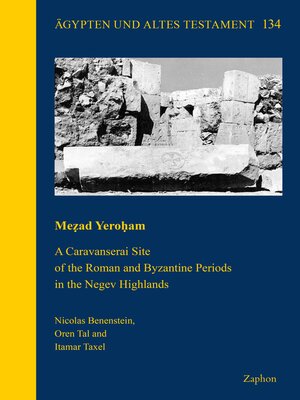Mezad Yeroham
ebook ∣ A Caravanserai Site of the Roman and Byzantine Periods in the Negev Highlands · Agypten und Altes Testament
By Nicolas Benenstein

Sign up to save your library
With an OverDrive account, you can save your favorite libraries for at-a-glance information about availability. Find out more about OverDrive accounts.
Find this title in Libby, the library reading app by OverDrive.



Search for a digital library with this title
Title found at these libraries:
| Library Name | Distance |
|---|---|
| Loading... |
Situated to the southwest of the modern town of Yeroham, in the heartland of other Negebite towns of the classical periods (Mampsis to its northeast, Elusa and Rehovot-in-the-Negev to its northwest, Nessana and Sobota to its southwest and Oboda to its south), the site of Mezad Yeroham has received little attention in modern research due to lack of publications. Surveyed by Palmer (1870) and Glueck (1954) and excavated by Cohen (1966-1967, 1993) and Baumgarten (2000), the site's four areas of excavations (A-D) revealed three layers of occupation dated from the Early Roman (1st/2nd century CE) through the Late Byzantine (6th and possibly early 7th century CE) period, based on the unearthed pottery and coins. While the early occupation at the site is restricted to Areas B and C, the site's current architectural landscape dates to the Byzantine period and illustrates a relatively dense settlement whose character - apparently a caravanserai with a few buildings of military and domestic (familial) nature - differs from contemporaneous Negebite large villages and townlets. This function and use may also hint at its character during earlier periods of occupation. One of the Greek ostraca found at the site mentions a toponym, Μαραμαθως, perhaps the site's ancient name which sadly is unrecorded in contemporaneous epigraphic material or known from historical sources. This study constitutes a full report of the site's excavations, dealing with its history of research, environs, architecture and stratigraphy, architectural sculpture, pottery, glass, stone (and other artifacts) and coins, as well as ostraca, dipinti and shells. The site's necropoleis and hinterland are also discussed in detail. The analysis of Mezad Yeroham is holistic in nature, based upon the finds recovered and the Zeitgeist of the current research of the classical periods in the Negev.







